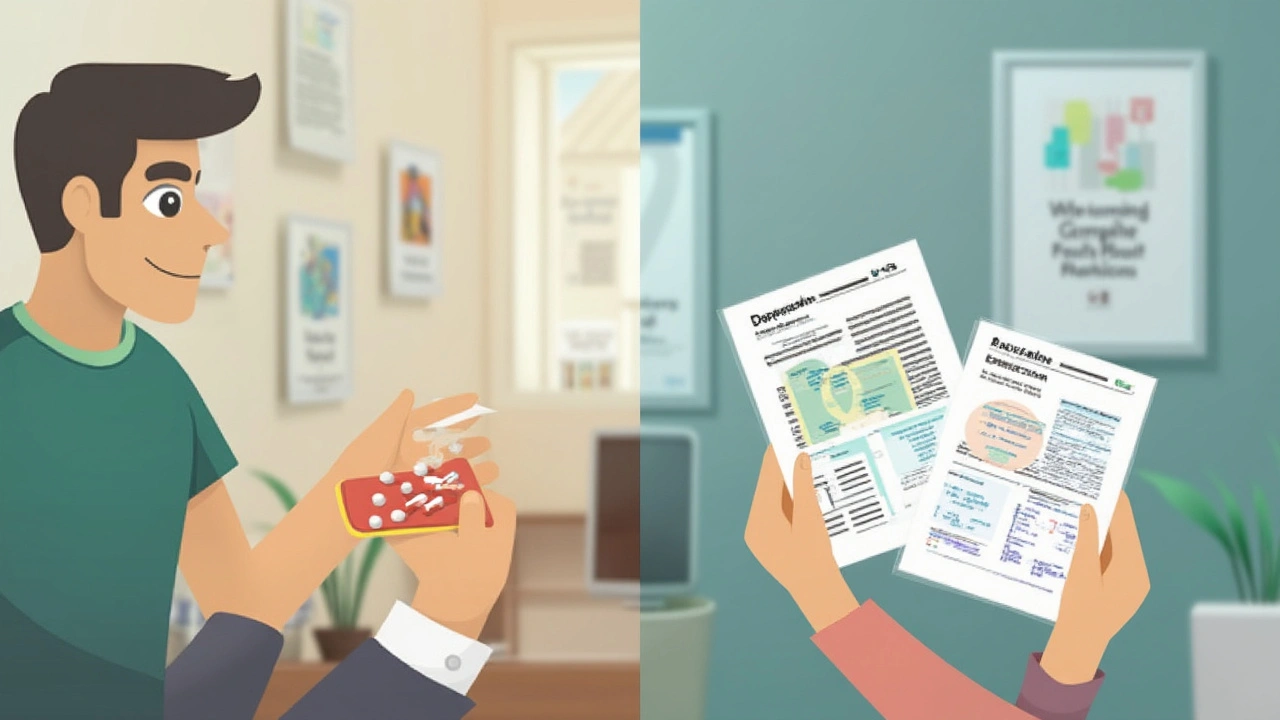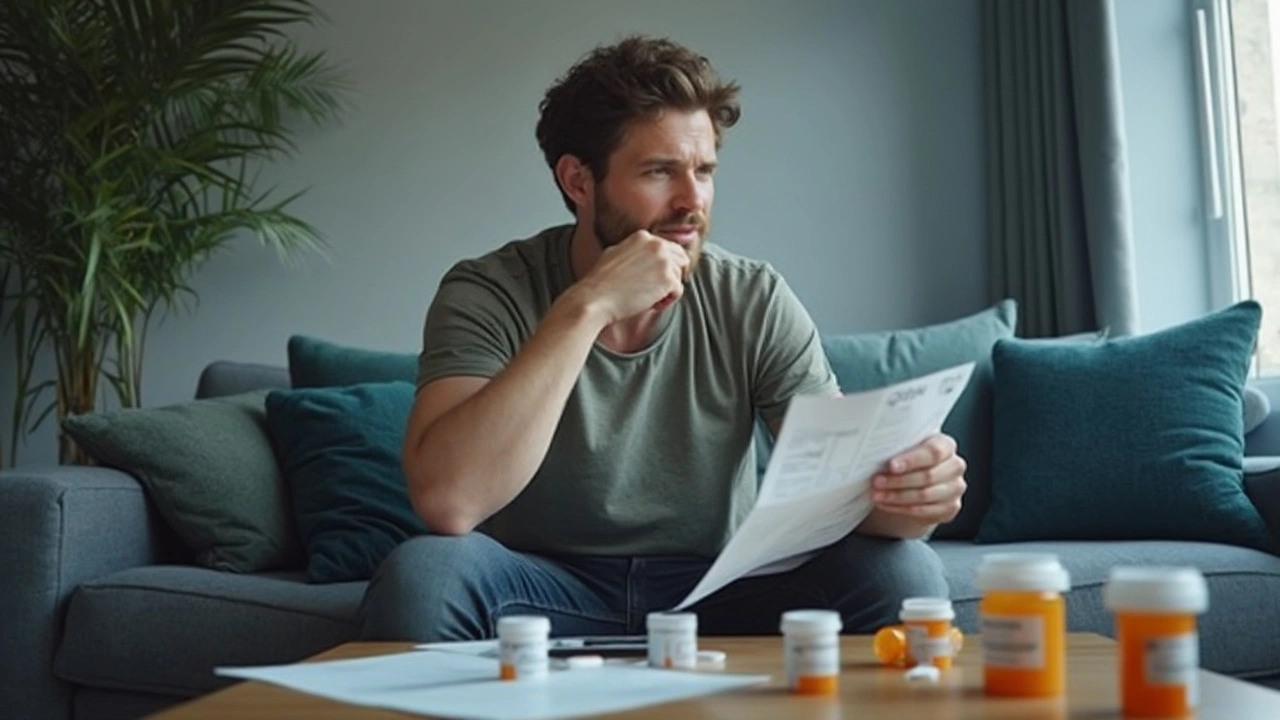Why Dapoxetine Isn’t for Everyone: The Real Patient Story
Here’s a reality a lot of guys run into but don’t talk about: not all medications for premature ejaculation (PE) are widely available, and even approved ones like dapoxetine substitute (the active ingredient in Priligy) can stop working, cause side effects, or become tough to get. Maybe your insurance gave you a hard time, maybe you got headaches or nausea, or maybe you checked online reviews and saw people frustrated about the medication wearing off too quickly. That’s pretty common: some men just don’t get the results they want, while others hate having to plan sex hours in advance just to get their timing right. You’re not alone in this; there are dozens of forums full of similar stories and even more search traffic each month for "best Dapoxetine alternatives." Why do people quit? Clinical studies show about 25% of users drop out because the side effects were too much, not because it didn’t work. Suddenly, you’re back to square one—looking for something that isn’t a shot in the dark. And doctors? They’ve seen it all, so let’s get straight to what they actually recommend as real substitutes when Dapoxetine isn’t the right fit.
Off-Label SSRIs: Not Just for Anxiety or Depression
It’s wild how drugs made for one thing can end up having a side gig for something totally different. In the case of PE, some selective serotonin reuptake inhibitors (SSRIs) are prescribed "off-label" because they have a surprising side effect: they can delay orgasm. So, instead of waiting for a new PE-specific drug to magically appear, urologists and primary care docs lean into what’s already in the medicine cabinet.
The big hitters here? Paroxetine, sertraline, fluoxetine, and citalopram. Paroxetine usually comes out on top—doctors say it typically gives the strongest effect, sometimes bumping up ejaculation times by over 300%. One research review in "The Journal of Urology" found that men on paroxetine every day could increase their intravaginal ejaculation latency time (IELT) from just under a minute to as much as five. That’s not science fiction. Sertraline and fluoxetine also help but might run a little gentler on side effects. Doctors tend to start with lower doses than what you’d get for depression, but no one-size-fits-all rule exists. Some guys only need to take them a few hours before intimacy, which is easier to schedule around real life. But, like every shortcut, there’s a trade-off: sexual side effects can be real, like trouble reaching orgasm at all or a drop in desire. Some people feel sluggish, get night sweats, or notice odd mood changes. Still, when Dapoxetine isn’t available—or it’s just too pricey—these off-label options are the go-to. That’s not just online gossip; leading urologists and sexual medicine clinics back this up in treatment guidelines.
If you’re curious about specific dosing or want to see side-by-side comparisons, clinics often recommend pulling data from tables like the one below for a snapshot of how these SSRIs stack up:
| SSRI | Typical Dose for PE | Average IELT Increase |
|---|---|---|
| Paroxetine | 10-20 mg daily | +300% |
| Sertraline | 25-50 mg daily | +200% |
| Fluoxetine | 20-40 mg daily | +150% |
| Citalopram | 20 mg daily | +170% |
No drug is a magic fix, but adjusting serotonin is one of the most established ways to delay ejaculation. — Dr. Michael Perelman, professor of psychiatry and sex therapy specialist
Tramadol: Painkiller, But Also a Secret Weapon?
It sounds counterintuitive, right? Why would a painkiller be useful for PE? Turns out, tramadol’s effect on certain neurotransmitters doesn’t just turn down pain—it delays climax for a lot of patients. Nurses and doctors first noticed this in men taking tramadol for injuries who suddenly found themselves lasting much longer in bed. It’s not just anecdotes, either. One well-designed clinical trial published in "The International Journal of Impotence Research" found men taking tramadol before sex could last about four times longer, on average, compared to their baseline.
Tramadol as a "wait, this might work for PE?" option is picking up a steady following. Some countries use it more routinely than others, but it’s definitely entering the conversation in American urology clinics. The typical trick is a low dose—often just 50-100 mg, taken one or two hours ahead of time. Doctors warn you have to be careful here: tramadol has a risk for addiction if you use it often, and mixing it with other depressants (like alcohol) can turn dangerous. Some guys deal with nausea or dizziness, and it isn’t for people with a history of seizures. But for otherwise healthy men who want to try something outside the SSRI family, tramadol stands out as a legit alternative. Again, this isn’t just wild speculation. Expert consensus papers from societies like the International Society for Sexual Medicine mention tramadol every year as a real PE treatment—just off-label.
If you want the whole menu of Dapoxetine substitute ideas ranked and reviewed, there’s a solid roundup that’s worth checking out for honest pros and cons.

Combination Therapy: The Double-Edged Sword
Doctors like to experiment when one medication alone doesn’t do the job. That’s how combo approaches wind up as a part of the PE conversation. Each man is different, and so mixing lower doses of two drugs—say, a mild SSRI with topical numbing cream—can give you the best of both worlds with fewer side effects. This strategy really shines in the clinic when the risks of higher doses beat the benefit of just one med.
Sometimes, urologists stick with the oral SSRI and add a condom with a benzocaine or lidocaine base. Another growing trend is combining tramadol with a small SSRI dose for synergy—just watch for doubled-up side effects, especially fatigue or nausea. Keep in mind that sexual psychology is just as crucial, so doctors sometimes toss in behavioral training or couples counseling. That might sound soft, but clinical trials prove that mind-and-medicine together beats either one alone in many cases. If you’re someone who’s tried everything single-file and felt let down, don’t be afraid to talk to your doc about mix-and-match tactics.
You might be surprised: evidence shows combo therapy can improve outcomes in up to 60% of men who struggle with monotherapy. Just don’t try this without medical supervision. Some drug combos can mess with your heart or make you sick if you get the ratios wrong. So, if you’re reading through forums and see guys self-medicating, take those stories with caution.
Tips for Switching Safely and What to Expect When You Change Meds
You want better results, but swapping out medications isn’t like changing snacks. Some PE drugs stick around in your system for days or even weeks. If you switch too quickly, you might stack side effects—or lose effectiveness altogether. Doctors recommend giving the new med at least two weeks (sometimes even longer) before judging if it’s working. Write down what you’re taking, when, and how you feel. Your doctor will thank you—and you’ll be able to spot what’s actually helping versus just noise.
Here’s a simple checklist to lower your risk:
- Always check with your physician or urologist before starting or stopping any PE med. Self-medicating is risky.
- Start with a low dose and work up only if you’re not getting side effects.
- Take extra care if you’re on other prescriptions, especially depressants or anything affecting your liver.
- Track your sexual response times honestly. Don’t exaggerate improvements for your doc—they need facts, not optimism.
- Check for non-drug triggers: stress, anxiety, sleep, relationship tension. Meds don’t fix these, and they matter.
Adjusting to a new routine can test your patience, but patience pays off. Clinical data suggests that after two to four weeks on a new SSRI or tramadol regimen, most men will know if the benefits outweigh the downsides. Don’t hesitate to push your doctor for other ideas if what you’re on isn’t working. There are always more arrows in the medical quiver.
The Future of PE Treatment: What’s Coming Next?
This field changes quickly. While Dapoxetine was the first and only officially approved "on-label" treatment, the horizon’s looking busy. Bioengineers and pharmaceutical companies are pushing out new oral sprays, topical gel formulas, and even wearable tech for biofeedback. Some clinical trial data hints that new classes of drugs—like oxytocin antagonists or innovative serotonin modulators—could give guys more options with fewer downsides. Realistically, though, these breakthroughs take years to clear testing and reach pharmacy shelves. Until then, you’re left with a toolkit: trusted off-label SSRIs, carefully-used tramadol, smart combination therapy, and good old-fashioned communication with your doctor.
If you’re lost in a sea of options and want something that fits your life (not just a textbook case), talk to medical pros who really listen. Medication can help, but smart choices and candid conversations move the needle the most. With new discoveries rolling out every year, better solutions are on the way—so don’t settle for "just OK." Keep asking, keep checking resources, and don’t be afraid to pivot if your current plan isn’t cutting it.





thilagavathi raj
May 1, 2025 AT 11:46Paroxetine is the real MVP. 300% IELT increase? That’s not a suggestion-it’s a fucking upgrade. No more panic mode before penetration. Just pop a 10mg and let serotonin do the heavy lifting. Side effects? Yeah, but so does coffee. You want performance, you pay the price.
Mitch Baumann
May 2, 2025 AT 14:57It’s fascinating-really, *fascinating*-how the medical community has quietly repurposed SSRIs for PE, almost as if they were always meant to serve this purpose… 🤔 The pharmacokinetic profiles align *so elegantly* with serotonergic modulation of the ejaculatory reflex… 🌟
Samuel Wood
May 4, 2025 AT 03:01tramadol is legit but dont forget its a class 4 controlled in the us now… its getting harder to get without a pain script… also dont mix with ssri’s unless u wanna be a human paperweight
ridar aeen
May 5, 2025 AT 02:25I tried sertraline for 6 weeks. Felt like a zombie during the day, but sex? Perfect. No more rushing. My partner noticed. We didn’t talk about it much-just smiled. Sometimes the quiet wins are the ones that last.
chantall meyer
May 7, 2025 AT 01:55People treat PE like a disease. It’s not. It’s biology. And biology doesn’t care about your schedule. SSRIs? Fine. But if you’re relying on pills to have sex, maybe the real problem is you’ve forgotten how to breathe.
Lorne Wellington
May 7, 2025 AT 15:53Hey everyone-just wanna say this is one of the clearest, most compassionate breakdowns I’ve seen on PE. Seriously. 🙌 I’ve been helping guys in my clinic with combo therapy for years: low-dose sertraline + lidocaine condom + 10 mins of diaphragmatic breathing before. It’s not magic. But it’s human. And that’s what matters. You’re not broken. You’re just adapting. Keep going.
Will RD
May 8, 2025 AT 06:13why are people taking daily ssris for pe? just take it 4 hours before. its not rocket science. also tramadol = bad idea. you dont want to be addicted to a painkiller just to last longer. duh.
Jacqueline Anwar
May 9, 2025 AT 15:55The clinical data presented here is methodologically unsound. IELT increases are self-reported, placebo-controlled trials are absent, and off-label use is not equivalent to FDA-approved efficacy. This post borders on medical misinformation.
Ganesh Kamble
May 11, 2025 AT 01:57lol all this fancy science and nobody just says ‘just slow down’? like… breathe? stretch? stop thinking about it? i’ve been doing it for 15 years. no pills. no creams. just chill the fuck out.
Shanna Talley
May 12, 2025 AT 21:36There’s no shame in needing help. What’s shameful is pretending you don’t. I used to think PE meant I was broken. Turns out, it just meant I hadn’t found my rhythm yet. SSRIs didn’t fix me-they gave me space to breathe. And that’s enough.
Gina Damiano
May 14, 2025 AT 05:11Wait so you’re telling me I can just take tramadol before sex and not have to worry about my partner noticing I’m nervous? I’ve been doing this wrong my whole life…
Emily Duke
May 15, 2025 AT 07:27My ex took paroxetine and turned into a zombie who couldn’t even kiss me without feeling ‘numb’… then he blamed ME for his ‘low libido’… like… maybe it’s the meds? 🤡
Kayleigh Walton
May 15, 2025 AT 18:00If you’re considering switching meds, please-*please*-don’t do it cold turkey. I went from dapoxetine to sertraline in 48 hours. Let’s just say my brain did not appreciate that. Took 3 weeks to stabilize. Talk to your doctor. Seriously. You’re worth the patience.
Stephen Tolero
May 17, 2025 AT 09:10What’s the half-life of fluoxetine compared to paroxetine in the context of on-demand use? Is there any data on plasma concentration thresholds for IELT modulation?
Brooklyn Andrews
May 18, 2025 AT 20:19My partner and I tried the combo thing-sertraline + numbing condom. Worked. We laughed about it. Now we just do it once a week. No pressure. No meds. Just… us. Sometimes the best fix is not fixing at all.
Joanne Haselden
May 20, 2025 AT 07:41SSRIs for PE are not ‘off-label’-they’re evidence-based. The ISIM guidelines explicitly endorse them. The problem isn’t the science. It’s the stigma. Men are taught to suffer in silence. This post? It’s a lifeline.
Vatsal Nathwani
May 20, 2025 AT 23:18all this talk about pills and dosages and i still think the real solution is just dating someone who doesn’t care if you last 2 minutes. problem solved.